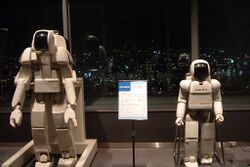Engineering:Honda P series
The P series is a series of prototype humanoid robots developed by Honda between 1993 and 2000. They were preceded by the Honda E series (whose development was not revealed to the public at the time) and followed by the ASIMO series, then the world's most advanced humanoid robots. Honda Motor's President and CEO Hiroyuki Yoshino, at the time, described Honda's humanoid robotics program as consistent with its direction to enhance human mobility.
History
Work to develop an advanced humanoid robot began in 1986, when Honda established a research center focused on fundamental technologies, including humanoid robotics.
Honda engineers had to research how humans walk, using the human skeleton for reference to create a replica and have it function like a human being. In 1986, the first two-legged robot was made to walk, used by Honda engineers to establish stable walking technology, including steps and sloped surfaces.
In 1993, Honda began developing "Prototype" models ("P" series), attaching the legs to a torso with arms that could perform basic tasks. P2, the second prototype model, debuted in December 1996, using wireless techniques making it the first self-regulating, two-legged walking robot. P2 weighed 463 pounds with a height of six feet tall. In September 1997, P3 was introduced as the first completely independent bi-pedal humanoid walking robot, standing five feet, four inches tall and weighing 287 pounds.[1]
Features
Honda engineers determined a robot should be easy to operate and small in size, enabling it to help people—for instance, to look eye to eye with someone sitting in a chair.
ASIMO can be controlled by a portable controller whereas P3 was controlled from a workstation.
| P1 (1993)1 |
P2 (1996) |
P3 (1997) |
P4 (2000)2 |
-> | ASIMO (2000) |
ASIMO (2005) | |
|---|---|---|---|---|---|---|---|
| Weight | 175 kg | 210 kg | 130 kg | 80 kg | 52 kg | 54 kg | |
| Height | 191.5 cm | 182.0 cm | 160.0 cm | 160.0 cm | 120.0 cm | 130.0 cm | |
| Width | 60.0 cm | 60.0 cm | 45.0 cm | 45.0 cm | |||
| Depth | 75.8 cm | 55.5 cm | 44.0 cm | 37.0 cm | |||
| Walking speed | 2 km/h | 2 km/h | 2 km/h | 1.6 km/h | 2.7 km/h (walking) 6 km/h (running) | ||
| Max working load | 5 kg/hand | 2 kg/hand | 1 kg (carrying) 10 kg (on cart) | ||||
| Battery | 135 V - 6 A·h - Ni-Zn | 38.4 V - NiMH | 51.8 V - Li-ion | ||||
| Continuous operating time | 15 minutes | 25 minutes | 30 minutes | 1 hour (walking)[3] | |||
| Degrees of freedom | 30 | 30 | 28 | 34 | 26 | 34 | |
| Image | 
|

|

|

|

| ||
Notes:
- 1.^ – The P1 was developed in 1993 but was not unveiled and Honda kept its existence a secret until the announcement of the P2 in 1996.
- 2.^ – The P4 was developed in 2000 and originally unveiled as "P3-improved prototype" (P3改良型試作機).[4][5] The model was announced as the "P4" in 2009.
See also
- Honda E series, experimental models
- Humanoid Robotics Project; the HRP-1 is a variant of the Honda P3.
References
- ↑ "ASIMO by Honda | The World's Most Advanced Humanoid Robot". https://asimo.honda.com/news/hondas-advanced-humanoid-robot-asimo-makes-us-debut/newsarticle_0008/. Retrieved 9 June 2023.
- ↑ 2.0 2.1 2.2 "History of Humanoids: P1-P2-P3 (1993 - 1997)". Honda Motor Co., Ltd.. http://world.honda.com/ASIMO/history/p1_p2_p3.html.
- ↑ "Asimo. Frequently Asked Questions". http://asimo.honda.com/downloads/pdf/asimo-technical-faq.pdf.
- ↑ "P3 Humanoid Robot" (in ja). Honda Robot Site (Honda). http://www.honda.co.jp/robot/about/new/.
- ↑ "幻の ASIMO 開発機「P4」を展示!" (in ja). Response.jp (IRI Commerce and Technology, Inc.). 2010-03-23. http://response.jp/article/2010/03/23/138013.html.
External links
 |


